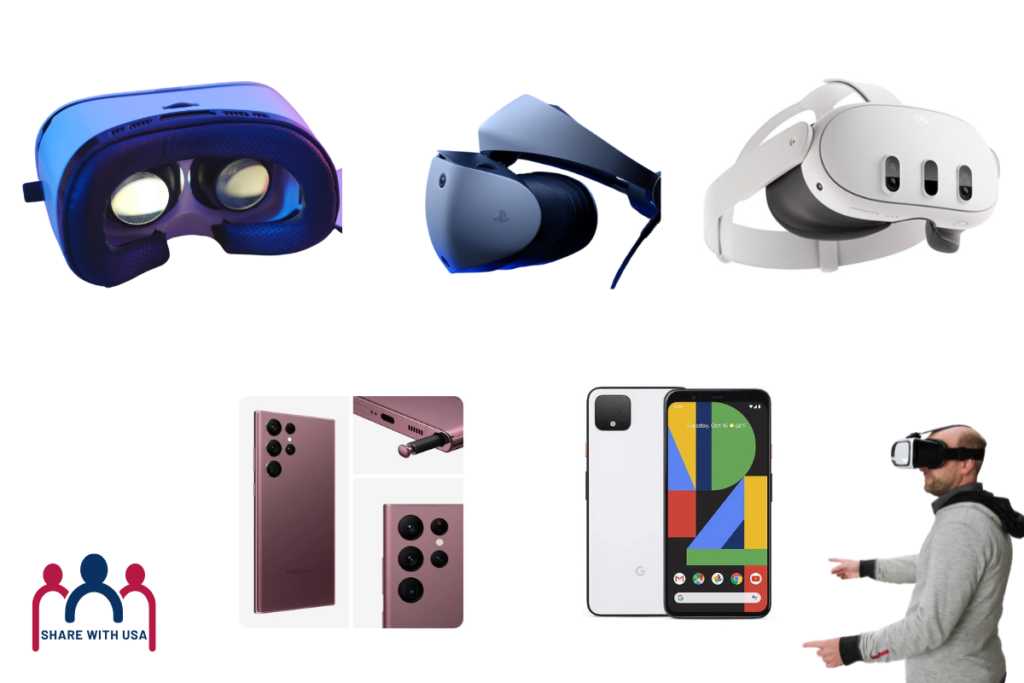In recent years, Virtual Reality (VR) and Augmented Reality (AR) have emerged as transformative technologies, revolutionizing how we interact with digital content and the world around us. As these immersive experiences become increasingly popular, the demand for specialized mobile devices capable of delivering high-quality VR and AR has skyrocketed. In this blog post, we’ll take a closer look at some of the commonly used specialized mobile devices for VR and AR in 2024.

-
Oculus Quest 3
The Oculus Quest series has been a game-changer in the world of VR, offering standalone headsets with built-in tracking and controllers. The Oculus Quest 3, released in 2023, boasts improved graphics, enhanced comfort, and increased processing power, making it an ideal choice for immersive VR experiences. With features like hand tracking and room-scale VR, the Oculus Quest 3 continues to lead the pack in the realm of mobile VR.
-
Apple AR Glasses
Rumors of Apple’s foray into augmented reality have been circulating for years, and in 2024, the tech giant finally unveiled its highly anticipated AR glasses. With sleek design and advanced AR capabilities, Apple’s AR glasses are poised to revolutionize how we interact with the world around us. Powered by Apple’s custom silicon and integrated with the iOS ecosystem, these glasses promise seamless integration with iPhones and iPads, opening up a world of possibilities for AR applications.
Also read: Unlocking the Potential of VR and AR: A Case Study on Mobile Devices 2024
-
Samsung Galaxy S22 Ultra
Samsung’s flagship smartphone, the Galaxy S22 Ultra, offers advanced features tailored for immersive VR and AR experiences. With a high-resolution display, powerful processor, and 5G connectivity, the Galaxy S22 Ultra delivers stunning visuals and smooth performance for VR applications. Additionally, Samsung’s partnership with Oculus provides access to a wide range of VR content through the Oculus Store, further enhancing the device’s appeal for VR enthusiasts.
-
Sony PlayStation VR2
Building on the success of the original PlayStation VR, Sony released the PlayStation VR2 in 2024, offering enhanced performance and improved ergonomics. Compatible with the PlayStation 5 console, the VR2 headset features upgraded displays, enhanced tracking, and redesigned controllers for a more immersive gaming experience. With Sony’s extensive library of VR titles and exclusive franchises, the PlayStation VR2 remains a top choice for console-based VR gaming.
-
Google Pixel ARCore
While Google has yet to release dedicated AR glasses, its ARCore platform continues to support AR experiences on a wide range of Android devices, including the Google Pixel series. With ARCore, developers can create immersive AR applications that leverage the device’s camera, sensors, and processing power to overlay digital content onto the real world. From interactive games to practical utilities, the Google Pixel with ARCore offers a versatile platform for AR enthusiasts.
Conclusion
As VR and AR technologies continue to evolve, the demand for specialized mobile devices capable of delivering immersive experiences is expected to grow. From standalone VR headsets to augmented reality glasses and powerful smartphones, the options for experiencing VR and AR in 2024 are more diverse and accessible than ever before. Whether you’re a gaming enthusiast, creative professional, or tech aficionado, there’s a specialized mobile device out there to suit your VR and AR needs.
In this blog post, we’ve explored some of the commonly used specialized mobile devices for VR and AR in 2024, highlighting their features, capabilities, and potential applications. As these technologies continue to mature and innovate, we can expect even more exciting developments in the years to come, further blurring the lines between the digital and physical worlds.

